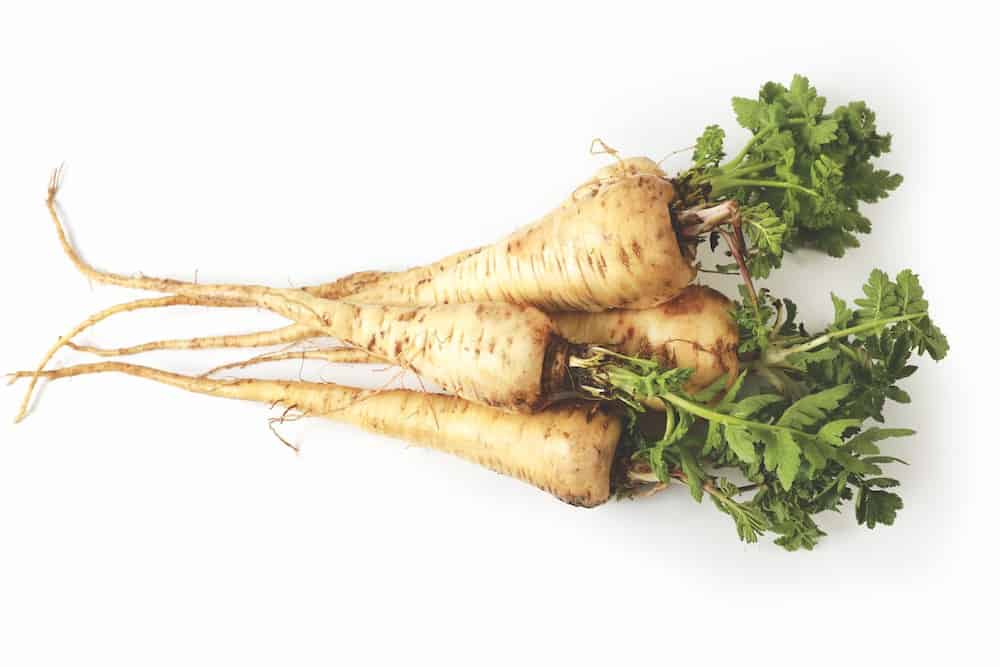
No, the parsnip is not just a “white carrot.” By relegating the ivory-colored root to the shadows of its more vibrant counterpart, it’s easy to miss out on its unique and deep flavor—and its versatility. Native to Europe and Western Asia and a relative of parsley, cumin, and dill—and yes, carrots—parsnips were cultivated and highly esteemed as early as the first century by the ancient Romans (so much so that the emperor Tiberius accepted the veggies as payment from his German subjects). For centuries thereafter, the sweet, starchy root grew to double as a widely available, inexpensive sweetener and a staple side dish. However, as cane sugar became more readily available and the potato was introduced from the Americas, parsnips soon became (and have remained) somewhat neglected.
Although the root doesn’t enjoy the same popularity as it once did—except for maybe in northern Europe and Parma, Italy, where it is a prized food for the pigs of prosciutto fame—it still has great potential for delight. The root is best adapted to colder climates and hits peak season in late fall and early winter, developing its characteristic sweet, nutty flavor with the first frost. During this time, seek out small to medium roots that are firm and heavy for their size; skip over any that are limp or blemished.
Want to try your hand at growing parsnips? The biennial vegetable has a long growing season—110 to 120 days—so plant your seeds as soon as the soil is workable. They are harvest-ready with the first cold snap, but the longer they sit underground, the sweeter they’ll be (just make sure to pull them before the soil freezes solid).
The options to enjoy parsnips are endless. Do as the British do and serve them alongside your next Sunday roast, or crisp them in the oven or a skillet and finish with freshly grated parmesan. Deep-fry for “chips,” bake into a cheesy gratin, braise in stews, or combine with leeks and crème fraîche for a silky-smooth soup. For a different take, grate ’em raw for an autumnal slaw or add parsnip puree to your favorite quick breads. In this regard, parsnips are like carrots—use the creamy white roots as you would their relative (parsnip cake, anyone?).
It’s easy to see that the humble parsnip is in fact mighty and, if given the chance, can shine in many guises. So, dig it out from under all those potatoes and carrots and let it finally see the light.
Parsnip Fritters with Gruyère
Ingredients
- 1 pound parsnips peeled and cored if necessary
- 1 large russet potato peeled
- 1 tablespoon fresh lemon juice
- 2 cloves garlic minced
- ¼ cup all-purpose flour
- 1 teaspoon baking powder
- 1 teaspoon kosher salt plus more to taste
- ¼ teaspoon freshly cracked black pepper plus more to taste
- ⅛ teaspoon ground nutmeg
- 1½ tablespoons finely chopped fresh thyme
- 1½ tablespoons finely chopped fresh parsley plus more to garnish
- 1 cup grated Gruyère cheese about 4 ounces
- 2 large eggs lightly beaten
- Neutral oil such as vegetable, canola, or grapeseed, for frying
- Sour cream for serving
Instructions
- Heat oven to 250°F and line a large rimmed baking sheet with parchment paper. Set aside.
- Grate parsnips and potato on large holes of a box grater or in a food processor. Squeeze handfuls of vegetables over a sink to remove as much liquid as possible. Toss with lemon juice and garlic in a large bowl.
- Whisk together flour, baking powder, salt, pepper, nutmeg, and fresh herbs in a small bowl. Add mixture to vegetables, add Gruyère, and toss to combine. Stir in eggs and mix until combined. Season with salt and pepper.
- Warm 3 to 4 tablespoons oil over medium heat in a large cast-iron skillet. Scoop large spoonfuls (2 to 3 tablespoons) of parsnip-potato mixture and drop into hot oil. Gently flatten each dollop with a spatula to create a flat disk. Cook until golden brown, 2 to 3 minutes, then flip and cook for an additional 2 to 3 minutes.
- Transfer cooked fritters to a paper towel–lined plate, then move to prepared baking sheet and keep warm in oven while you fry remaining batches, adding more oil to skillet as needed.
- Garnish fritters with parsley and serve with sour cream on the side.



